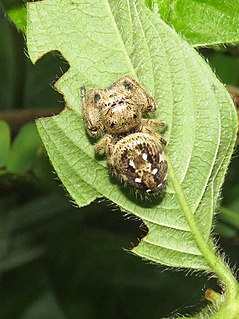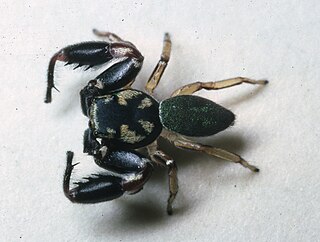Bocus is a genus of Southeast Asian jumping spiders that was first described by George Peckham & Elizabeth Peckham in 1892. As of June 2019 it contains only three species, found only in the Philippines and Indonesia: B. angusticollis, B. excelsus, and B. philippinensis. They are indistinguishable from the related genus Myrmarachne without the help of a microscope.
Damoetas is a monotypic genus of Australian jumping spiders containing the single species, Damoetas nitidus. It was first described by George and Elizabeth Peckham in 1886, and is only found in New South Wales and Queensland. Two species that were once in this family, Damoetas christae and Damoetas galianoae have since been moved to Myrmavola.
Erica eugenia is a species of jumping spiders. It is the only species in the monotypic genus Erica. It was first described by George and Elizabeth Peckham in 1892, and is only found in Brazil and Panama.

Hypoblemum is a genus of South Pacific jumping spiders that was first described by George and Elizabeth Peckham in 1886. The taxonomy was radically revised in 2019.
Maileus is a monotypic genus of jumping spiders containing the single species, Maileus fuscus. It was first described by G. Peckham & Elizabeth Peckham in 1907, and is only found on Borneo. It is closely related to the genus Microhasarius.
Marengo is a genus of Asian jumping spiders that was first described by George and Elizabeth Peckham in 1892. The name is derived from Marengo, a village in Italy and the name of Napoleon's horse.
Microhasarius is a spider genus of the jumping spider family, Salticidae.
Nagaina is a genus of jumping spiders that was first described by George and Elizabeth Peckham in 1896. The name is derived from Nagaina, a character from Rudyard Kipling's Rikki-Tikki-Tavi. Other salticid genera with names of Kipling's characters include Bagheera, Messua, and Akela.
Paradamoetas is a genus of jumping spiders that was first described by George and Elizabeth Peckham in 1885. The name is a combination of the Ancient Greek "para" (παρά), meaning "alongside", and the salticid genus Damoetas.
Parajotus is a genus of African jumping spiders that was first described by George and Elizabeth Peckham in 1903. As of August 2019 it contains only three species, found only in Africa: P. cinereus, P. obscurofemoratus, and P. refulgens. The name is a combination of the Ancient Greek "para" (παρά), meaning "alongside", and the related genus Jotus.

Parnaenus is a genus of jumping spiders that was first described by George and Elizabeth Peckham in 1896. As of August 2019 it contains only three species, found only in South America, El Salvador, and Guatemala: P. cuspidatus, P. cyanidens, and P. metallicus.

Rudra is a genus of jumping spiders that was first described by George and Elizabeth Peckham in 1885. The name refers to Rudra, a Rigvedic god.
Selimus is a monotypic genus of Brazilian jumping spiders containing the single species, Selimus venustus. It was first described by George and Elizabeth Peckham in 1901, known from a single male found in Brazil. The species name is derived from Latin venustus "charming".
Sonoita is a monotypic genus of jumping spiders containing the single species, Sonoita lightfooti. It was first described by George and Elizabeth Peckham in 1903, and is found only in Africa.
Taivala is a monotypic genus of jumping spiders containing the single species, Taivala invisitata. It was first described by G. Peckham & Elizabeth Peckham in 1907, and is found in Sarawak, Borneo. Only females have been found, but it is thought to be closely related to Pseudamycus. A female epigyne was drawn by Proszynski in 1984.
Tacuna is a genus of South American jumping spiders that was first described by George and Elizabeth Peckham in 1901.
Tara is a genus of Australian jumping spiders that was first described by George and Elizabeth Peckham in 1886. As of August 2019 it contains only three species, found only in New South Wales: T. anomala, T. gratiosa, and T. parvula.
Vailimia is a genus of Asian jumping spiders that was first described by C. F. Kammerer in 2006. It was first described in 1907 from a single male about 6 millimetres (0.24 in) long. It was originally thought to be close to Harmochirus, but the male pedipalp, chelicera, and cephalothorax drawn by Proszynski in 1984, and information gained from later collected specimens indicates otherwise. Subsequently, three more species have been identified. It may be a synonym for Pancorius.
Massagris mirifica is a jumping spider species in the genus Massagris that lives in South Africa. The male was first identified by George and Elizabeth Peckham in 1903.
Habronattus elegans is a species of spiders in the family Salticidae. It is found in the United States and in Mexico.


